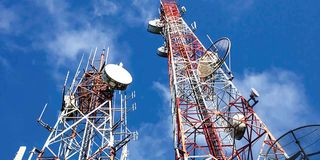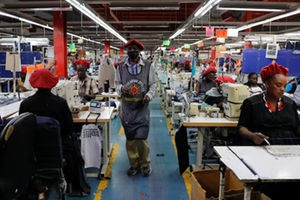Investment in telecom infrastructure to bridge digital divide

What you need to know:
- Dar es Salaam is leading with (1158), followed by Mwanza (422), Morogoro (421), Dodoma (414), Arusha (404), Tanga (392), Mbeya (368), Kagera (352), Tabora (327) and Ruvuma (318), while Zanzibar lags.
Dar es Salaam. Tanzania continues to embrace the digital economy and improve its communication infrastructure, with the country currently having 8,551 communication towers to boost access to internet services, and stakeholders are encouraged to invest more in this sector.
Dar es Salaam is leading with (1158), followed by Mwanza (422), Morogoro (421), Dodoma (414), Arusha (404), Tanga (392), Mbeya (368), Kagera (352), Tabora (327) and Ruvuma (318), while Zanzibar lags.
A second quarter of the communications statistics report released by Tanzania Communications Regulatory Authority (TCRA) for April to June this year has come up with an aspect to show the number of telecom towers in Tanzania where the stakeholders say many towers improve the connectivity.
Last year, the government under the Universal Communications Service Access Fund (UCSAF) and telecom companies signed an agreement where we will see five telecommunication companies build 758 new towers worth Sh265.3 billion in 713 wards on the Mainland and some 304 other towers that currently provide 2G internet services upgraded to 3G and 4G.
Speaking to The Citizen yesterday, TCRA head of communication and public relations, Mr Rolf Kibaja, said: “If you compare the number of towers and percentage of people reached by the internet, it clearly shows that towers are still needed in the country to facilitate the increase in access to internet services in the country, and thus there is a need for more investment and development of this communication infrastructure.”
The report indicated that internet subscriptions rose from 36.8 million as of March to 39.3 million in June.
He said there are opportunities to build towers; there is a specific licence to build communication infrastructure (Network Facilities License) that enables investors to build towers in various locations and finally rent their towers to service providers for installing communication equipment.
In addition, note that the government also provides subsidies to build towers in areas with no commercial appetite, and thus the information facilitates plans for projects aimed at improving communication in areas with poor services as well.
Mr Kibaja added that, considering the importance of the environment, the government, through TCRA, insists on the use of this infrastructure in collaboration (tower sharing) with more than two service providers for one tower according to the existing regulations and guidelines, which helps in reducing the number of towers in different places in this country.
Commenting on the general report authority’s director general, Dr Jabiri Bakari, said: “The communications sector in the quarter ending June 2024 experienced significant progress and a notable increase in the adoption of telecommunication services, driven by the continued competitiveness of service tariffs.”
Dr Bakari said this growth reflects the sector’s dynamic evolution in response to user demands. “These combined improvements across the communications sector are crucial for fostering a more connected and digitally empowered society.”
Speaking to The Citizen yesterday, University of Dar es Salaam (UDSM) Telecommunications lecturer Dr Moses Ismail said that towers are essential for providing last-mile coverage connectivity; therefore, when there are many towers in a relevant area, communication improves.
He explained that areas with low coverage experience poor signal strength, making it difficult to make calls, adding that the number and size of towers depend on the area's characteristics.
For example, urban areas with high population density in a small area require fewer towers in contrast to rural areas, which need many towers to provide adequate coverage, especially for high-technology networks like 3G, 4G, and 5G that carry large amounts of data.
“There are opportunities in rural areas, but the challenge is that having many towers requires a significant investment, especially in village areas. Investors are often reluctant to invest there due to the high costs associated with land and infrastructure,” he said.
On the other hand, Tigo Tanzania's director of Network Planning and Engineering, Mr Semvua Kissenge, said there are indeed regions with fewer towers comparatively, hence an opportunity to continue investing.
Tigo's strategy is to ensure that every Tanzanian can access the best telecommunication services, which is evident through our network modernization and expansion initiative, where we have deployed 4G technology across the country and 5G in strategic towns.
“The plan is to continue to invest in expanding our current network infrastructure footprint to narrow the gap depending on customer and business needs to ensure that everyone benefits from the digital economy irrespective of geographical location,” he said.
Mr Kissenge said the company is committed to expanding physical towers deployed countrywide by sharing or building new sites. “We are determined to increase our current number to approximately 5000 active infrastructure footprints by the end of 2025.”
On environmental issues, “We employ clean energy solutions like solar power to minimise carbon emissions. Also, it utilises building rooftops, billboards, lamp posts, and indoor sites alongside physical towers in urban areas to maintain the aesthetics and neatness of cities and towns.”
In conclusion, Tigo is committed to expanding and maintaining a robust and environmentally responsible network infrastructure to provide stable and reliable communication services throughout Tanzania for sustainable business.
Additionally, we employ clean energy solutions like solar power to minimise carbon emissions. Also, Tigo is utilising building rooftops, billboards, lamp posts, and indoor sites alongside physical towers in urban areas to maintain the aesthetics and neatness of cities and towns.




